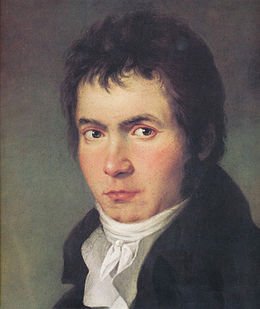Symphony No. 4 (Beethoven)
| Symphony in B-flat major | |
|---|---|
| No. 4 | |
| by Ludwig van Beethoven | |

Portrait of the composer in 1804
|
|
| Catalogue | Op. 60 |
| Style | Classical period |
| Composed | 1806 |
| Dedication | Franz von Oppersdorff |
| Performed | March 1807: Vienna |
| Movements | Four |
The Symphony No. 4 in B-flat major, Op. 60, is a symphony in four movements composed by Ludwig van Beethoven in the summer of 1806. It was premièred in March 1807 at a private concert at the home of Joseph Franz von Lobkowitz.
The work was dedicated to Count Franz von Oppersdorff, a relative of Beethoven's patron, Prince Lichnowsky. The Count met Beethoven when he traveled to Lichnowsky's summer home, where Beethoven was staying. Von Oppersdorff listened to Beethoven's Symphony No. 2 in D major, and liked it so much that he offered a large amount of money for Beethoven to compose a new symphony for him. Beethoven undertook the new work during the summer of 1806 and completed it in roughly a month, while also working on the Fourth Piano Concerto and revising his opera Fidelio, then still known as Leonore. The dedication was made to "the Silesian nobleman Count Franz von Oppersdorf".Hector Berlioz was so enamoured of the symphony's 2nd movement that he claimed it was the work of the Archangel Michael, and not that of a human.Robert Schumann called Beethoven's graceful Fourth Symphony "a slender Greek maiden between two Norse giants" (i.e., the 3rd and 5th).
The symphony is scored for flute, 2 oboes, 2 clarinets in B♭, 2 bassoons, 2 horns in B♭ and E♭, 2 trumpets in B♭ and E♭, timpani and strings.
...
Wikipedia
